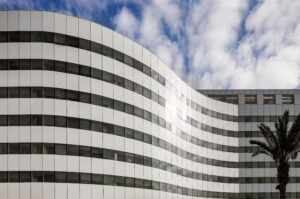Acoustic Curtain Walls: Definition
Acoustic curtain walls are curtain walling with the ability to attenuate noise at a level of 50db and higher.
These days, noise has increasingly become a pollutant, particularly in large cities with growing population density.
Most high rise office and residential blocks are located in large cities, and suffer from noise pollution at increasing levels.
Noise at 60-80db is annoying, yet we are surrounded by it for most hours of the day. This level of noise derives from several environmental factors, including vehicular traffic, trains, jets, manufacturing plants, pedestrian congestion, and more.
ALUMINUM CONSTRUCTION researches, develops and engineers curtain walls based on its in-depth studies of noise pollution in depth. The company has developed curtain walls that allow exceptional acoustic attenuation.
Basic to understanding how it becomes possible to attenuate noise at high levels, it is first necessary to understand the relationship between the cause of noise, and the noise produced, as detailed in the table below:
Source of noise | Noise level – db | |
Absolute silence | 0 | |
Desert silence | 10 | |
Whisper | 20 | |
Pastoral village | 30 | |
Normal speaking voice | 40 | |
Quiet residential unit | 50 | |
Loud speaking voice | 60 | NOISE POLLUTION |
Pedestrian filled street | 70 | |
Heavy road traffic | 80 | |
Orchestra in hall | 90 | |
Train pulling into station | 100 | |
Lawnmower | 110 | |
Truck horn | 120 | |
747 jet engine | 130 |
Acoustic attenuation can be presented in two ways:
1. RW (acoustic reduction) calculated according to the DIN52210 German Standard, used as the basis to create the ISO717 Standard. RW values chiefly handle noise reduction caused by noise pollutants such as hooting of vehicles and trains, jet engines, and so on.
2. RA values are primarily applied in France and Holland to handle traffic noise, or low and medium frequency noise.
- We present the noise reduction abilities of glass we most frequently use, being insulation glass made of two layers of equal thickness with a fixed space between them. Below are the reduction data:
Type of glass | Reduction RA (dba) | Acoustic RW (db) | ||||
Total thickness | External glass | Space | Internal glass | |||
Insulation glass | 20 | 4 | 12 | 4 | 25 | 29 |
Insulation glass | 24 | 6 | 12 | 6 | 27 | 31 |
Insulation glass | 28 | 8 | 12 | 8 | 29 | 32 |
Insulation glass | 26 | 6 | 12 | 8 | 30 | 33 |
Insulation glass | 32 | 10 | 12 | 10 | 30 | 34 |
Insulation glass | ||||||
- People tend to want to be somewhere quiet, where measured noise does not top 40db. Noise pollution is described as being in the 60db to 90db range, so noise reduction needs to be some 50db. From the table above, however, it is clear that the generally achieved reduction is not suited to the environments where we want to live and work.
- ALUMINUM CONSTRUCTION therefore developed a structural curtain wall glazed with insulation glass at a thickness of 100 mm with the following characteristics.
- ALUMINUM CONSTRUCTION research shows that increasing the space between the two sheets of glass beyond the norm (100 mm) and filling that space with inert accessible gases that are not air, while simultaneously altering the relv thicknesses of the internal and external panels of glass and separating the glass from the internal frame, allows reaching the required reduction values of 50db and more.
- The curtain wall is structural, and the internal aluminum profiles are packed with foamed, rigid, stable material.
- The internal and external glass panels are of different thicknesses.
- The frame between the two glass panels is separated from the glass by soft, flexible butyl sheeting (10 shor).
- The space between the two glass panels is injected a a mixture of gases.
- This glass curtain wall has been installed in the company’s laboratory and checked for a spectrum of frequencies matching the RW values. Results showed a reduction of 55db.
Conclusion
- A structural curtain wall with profile spaces filled by foamed rigid material
- Altered glass thickness, where the external glass is thicker than internal panel
- Flexible separation between the glass panels and the frame separating the panels
- Larger space between the glass panels, of 100 mm
- Penetration of gasses which are not air, and which contribute to acoustic attenuation
Summary
Enjoying a comfortable life behind glass requires seriously addressing the need to neutralize noise pollution, since most high rise structures worldwide have glass cladding that allows maximizing access to light while neutralizing escape of heat.
Today more than ever before is the perfect time to promote the idea of increased acoustic attenuation in these high rise structures.
ALUMINUM CONSTRUCTION offers a high rise tower classing solution that neutralizes noise pollution.
Rami Boneh, CEO
ALUMINUM CONSTRUCTION C.L. Ltd
ALUMINUM CONSTRUCTION Peru Ltd


